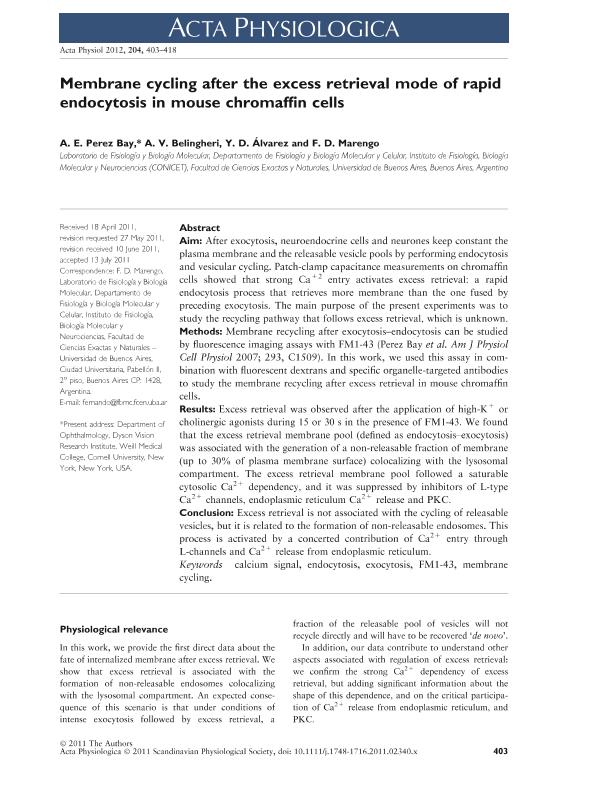Mostrar el registro sencillo del ítem
dc.contributor.author
Perez Bay, Andrés Ezequiel

dc.contributor.author
Belingheri, Ana Verónica

dc.contributor.author
Alvarez, Yanina Daniela

dc.contributor.author
Marengo, Fernando Diego

dc.date.available
2017-07-12T20:33:20Z
dc.date.issued
2013-03
dc.identifier.citation
Perez Bay, Andrés Ezequiel; Belingheri, Ana Verónica; Alvarez, Yanina Daniela; Marengo, Fernando Diego; Membrane cycling after the excess retrieval mode of rapid endocytosis in mouse chromaffin cells; Wiley; Acta Physiologica; 204; 3; 3-2013; 403-418
dc.identifier.uri
http://hdl.handle.net/11336/20272
dc.description.abstract
Aim: After exocytosis, neuroendocrine cells and neurones keep constant the plasma membrane and the releasable vesicle pools by performing endocytosis and vesicular cycling. Patch-clamp capacitance measurements on chromaffin cells showed that strong Ca+2 entry activates excess retrieval: a rapid endocytosis process that retrieves more membrane than the one fused by preceding exocytosis. The main purpose of the present experiments was to study the recycling pathway that follows excess retrieval, which is unknown. Methods: Membrane recycling after exocytosis–endocytosis can be studied by fluorescence imaging assays with FM1-43 (Perez Bay et al. Am J Physiol Cell Physiol 2007; 293, C1509). In this work, we used this assay in combination with fluorescent dextrans and specific organelle-targeted antibodies to study the membrane recycling after excess retrieval in mouse chromaffin cells. Results: Excess retrieval was observed after the application of high-K+ or cholinergic agonists during 15 or 30 s in the presence of FM1-43. We found that the excess retrieval membrane pool (defined as endocytosis–exocytosis) was associated with the generation of a non-releasable fraction of membrane (up to 30% of plasma membrane surface) colocalizing with the lysosomal compartment. The excess retrieval membrane pool followed a saturable cytosolic Ca2+ dependency, and it was suppressed by inhibitors of L-type Ca2+ channels, endoplasmic reticulum Ca2+ release and PKC. Conclusion: Excess retrieval is not associated with the cycling of releasable vesicles, but it is related to the formation of non-releasable endosomes. This process is activated by a concerted contribution of Ca2+ entry through L-channels and Ca2+ release from endoplasmic reticulum.
dc.format
application/pdf
dc.language.iso
eng
dc.publisher
Wiley

dc.rights
info:eu-repo/semantics/openAccess
dc.rights.uri
https://creativecommons.org/licenses/by-nc-sa/2.5/ar/
dc.subject
Membraneccycling
dc.subject
Excess Retrieval
dc.subject
Rapid Endocytosis
dc.subject
Chromaffin Cells
dc.subject.classification
Otras Ciencias Biológicas

dc.subject.classification
Ciencias Biológicas

dc.subject.classification
CIENCIAS NATURALES Y EXACTAS

dc.title
Membrane cycling after the excess retrieval mode of rapid endocytosis in mouse chromaffin cells
dc.type
info:eu-repo/semantics/article
dc.type
info:ar-repo/semantics/artículo
dc.type
info:eu-repo/semantics/publishedVersion
dc.date.updated
2017-07-12T14:52:00Z
dc.identifier.eissn
1748-1716
dc.journal.volume
204
dc.journal.number
3
dc.journal.pagination
403-418
dc.journal.pais
Estados Unidos

dc.journal.ciudad
Hoboken
dc.description.fil
Fil: Perez Bay, Andrés Ezequiel. Consejo Nacional de Investigaciones Científicas y Técnicas. Oficina de Coordinación Administrativa Ciudad Universitaria. Instituto de Fisiología, Biología Molecular y Neurociencias. Universidad de Buenos Aires. Facultad de Ciencias Exactas y Naturales. Instituto de Fisiología, Biología Molecular y Neurociencias; Argentina
dc.description.fil
Fil: Belingheri, Ana Verónica. Consejo Nacional de Investigaciones Científicas y Técnicas. Oficina de Coordinación Administrativa Ciudad Universitaria. Instituto de Fisiología, Biología Molecular y Neurociencias. Universidad de Buenos Aires. Facultad de Ciencias Exactas y Naturales. Instituto de Fisiología, Biología Molecular y Neurociencias; Argentina
dc.description.fil
Fil: Alvarez, Yanina Daniela. Consejo Nacional de Investigaciones Científicas y Técnicas. Oficina de Coordinación Administrativa Ciudad Universitaria. Instituto de Fisiología, Biología Molecular y Neurociencias. Universidad de Buenos Aires. Facultad de Ciencias Exactas y Naturales. Instituto de Fisiología, Biología Molecular y Neurociencias; Argentina
dc.description.fil
Fil: Marengo, Fernando Diego. Consejo Nacional de Investigaciones Científicas y Técnicas. Oficina de Coordinación Administrativa Ciudad Universitaria. Instituto de Fisiología, Biología Molecular y Neurociencias. Universidad de Buenos Aires. Facultad de Ciencias Exactas y Naturales. Instituto de Fisiología, Biología Molecular y Neurociencias; Argentina
dc.journal.title
Acta Physiologica

dc.relation.alternativeid
info:eu-repo/semantics/altIdentifier/doi/http://dx.doi.org/10.1111/j.1748-1716.2011.02340.x
dc.relation.alternativeid
info:eu-repo/semantics/altIdentifier/url/http://onlinelibrary.wiley.com/doi/10.1111/j.1748-1716.2011.02340.x/abstract
Archivos asociados
